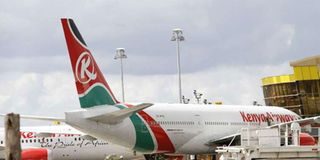Kenya Airways set for huge losses as planes and staff idle

Kenya Airways aeroplanes at the Jomo Kenyatta International Airport on March 27, 2015. PHOTO | JEFF ANGOTE | NATION MEDIA GROUP
What you need to know:
- In a catch-22 situation, Kenya Airways cannot sell planes yet it also cannot afford to maintain them and bring them back into service.
- Their crew, including pilots, are idle yet still on the payroll. An attempt two months ago to “redeploy” them to rival Ethiopian Airlines failed when the pilots’ association rejected it.
Troubled national carrier Kenya Airways is set to announce more losses running into billions of shillings as some of its critical assets in planes and pilots lie idle.
Two Boeing planes bought as part of the failed Project Mawingu expansion have been idling at the Jomo Kenyatta International Airport for more than a year.
In a catch-22 situation, the airline cannot sell them yet it also cannot afford to maintain them and bring them back into service.
Their crew, including pilots, are idle yet still on the payroll. An attempt two months ago to “redeploy” them to rival Ethiopian Airlines failed when the pilots’ association rejected it.
The airline’s financial year ended on March 31 and the results are being awaited.
But a board paper prepared by sacked Group Finance Director Alex Mbugua early in March should help prepare shareholders to absorb the coming blow.
“Kenya Airways has been performing dismally in the last four years reporting losses before tax of Sh10.8 billion, Sh4.8 billion and Sh29.7 billion in 2013, 2014 and 2015 respectively. The loss for the year to March 2016 will be in excess of Sh20 billion,” it says.
Part of these losses will be attributed to two Boeing planes rotting in the parking yard of JKIA since May 2015 and their idle crew who are still on the payroll.
The Boeing 777-200 aircraft are part of an original fleet of four planes. Straight out of the Boeing plant in Seattle, US, each plane cost $250 million (Sh25.3 billion).
They had been bought as part of the expansionist project which failed largely because of lack of passenger capacity on many of the routes the airline deployed them.
In November, 2014, as part of its efforts to cut its losses, the airline advertised them for sale. Sources within the airline told the Nation that a South African company offered $322 million (Sh32.6 billion) for the four planes. The deal was never consummated and in May 2015, the planes were grounded.
It later sold two of them to Omnia, an American charter carrier, for $2 million (Sh202.2 million) each – an unbelievable bargain for Omnia given the aforementioned prices. This left the other two planes. The prospect of selling them diminishes with every passing day.
In an email to Kenya Airways chief executive officer (CEO) Mbuvi Ngunze in July 2015, one captain wrote in angst: “Whilst returning from London last Friday, I saw them [the 777s] parked alongside others, which are destined for the graveyard. I felt very sad. One of the fastest ways of 'killing' an aircraft is parking it. Parking an aircraft to sell it later is not an option. If one needs to park an aircraft, the best place is the Mojave Desert (Mojave is in California, US). The air is very dry there and aircraft can be preserved for a long time”.
Mr Ngunze did not reply to this email.
SIMILAR PAIN
Last month, another captain obviously in similar pain wrote to the CEO saying: “We have two B777-200’s grounded. They are wholly owned and quite likely un-sellable in the current market. That the CEO of Delta Airlines can boast of buying identical planes for as little as $7 million apiece means it is clear that any residual value in our planes is very low and decreasing by the day. We still have the qualified crew to operate them and the engineers to service them. These pilots, myself included, are sitting idle but still on the payroll and KQ (Kenya Airways) seems to be at a loss as to what to do with us”.
He was pleading with Mr Mbuvi to rethink disposing of the B777.
He got a sobering answer from Yves Guibert, the airline’s outgoing chief operating officer.
Said Mr Guibert: “For the 777-200, we still have two aircraft here as you mentioned. Should we wish to make these two aircraft airworthy, we would need to invest in excess of 10 million USD (Sh1 billion) as we grounded them before some major maintenance items were due”.
The airline failed to answer one point raised in the email: what was Kenya Airways' plan B if it couldn’t sell them?
Also, what does it plan to do with its idle dozens of 777 staff after selling, grounding or leasing the planes they fly? They are still on its payroll.
Another problem is snowballing. The airline replaced its B777s with the smaller but more fuel efficient 787-8 Dreamliner for its long haul routes. This week a source at the airline told us: “The Boeing 787-8 fleet is stretched to the limits with hardly any time left for servicing the aircraft. Frequent breakdowns have resulted in delays, cancellations and huge hotel bills, as passengers are accommodated after cancellations”.
But Mr Mbugua’s diagnosis of the disease is completely different. He says: “The problem in KQ currently and over the last few years has been revenue, revenue, and revenue!”





